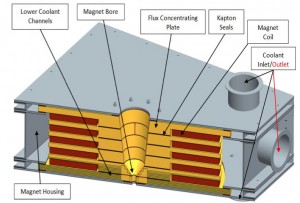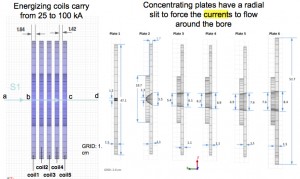A lot can happen in a millisecond. Major news agencies compete over milliseconds to be the first to publish breaking stories. In one millisecond, light travels from Geneva, Switzerland to Genoa, Italy.
And for a magnet in the ILC positron source, a millisecond is the length of time it must remain strong enough to focus particles coming from 2,820 positron bunches. For a case such as this, enduring for a millisecond is like running a marathon.
Scientists at Lawrence Livermore National Laboratory in the US have just completed the design of the ILC’s flux-concentrating magnet, a device that coaxes positrons down the right path early in their journey through the collider. Magnets of this type are standard in accelerator technology, but they’re typically built to maintain their field strength for scant microseconds – thousandths of a millisecond.
“The real issue is designing something you can run 24-7 for a year and have it hold together without any problems,” said Livermore’s Jeff Gronberg, who is leading the project to design, build and test the flux-concentrating magnet.
When positrons are first created in a positron target, they are disorderly, carrying many different energies and moving in many different directions. The flux-concentrating magnet, or flux concentrator, captures and focuses as many of these disorganised positrons as it can so they can be more easily accelerated.
“We’re very concerned with keeping a constant number of positrons coming off the system’s target,” Gronberg said.
To keep that number constant, the field of the magnet has to last the length of a positron bunch train, about a millisecond. (To meet ILC specifications, it must do so five times every second, which is how often a bunch train is produced.) The magnetic field’s endurance depends on the stability of the materials that make up the flux concentrator and on the electrical current that flows through it.
Livermore’s flux concentrator is made of six vertical copper plates, each about a centimetre thick. Affixed to each plate is an energising coil of current-carrying wire, which induces another current in its copper plate.
A precisely tapered bore, narrow at one end and wide at the other, runs through the centre of the stack of plates. It is through this bore that the magnetic field, induced by the currents in the plate and in the energising coil, is concentrated.
Almost as soon as positrons are produced, they enter the bore through the narrow end. The magnetic field inside focuses the positron bunches, preparing them for acceleration by the time the exit through the other side.
The effectiveness of the focusing is owed to the specific profile of the magnetic field, optimised for concentrating the positrons into a nice, narrow beam. Around five teslas at the bore’s entrance and about 0.5 tesla at the exit, this is the field profile that must be maintained for one millisecond, five times every second. Scientists at Argonne National Laboratory in the US performed particle simulations to determine the field strengths that best met ILC positron bunch specifications.
“At Argonne, we developed a magnetic profile with a tremendous focusing effect,” said Wei Gai, Global Design Effort positron technical area group leader. “Now the challenge for Livermore is to build it.”
The challenges are, of course, numerous.
The magnetic profile depends on the strength of the currents circulating in the copper plates. The plates are kept cold to lower their resistance, allowing them to more easily conduct electricity. But even at temperatures as low as 77 kelvins, the conducting plates can’t help losing some current over the time it takes the bunch train to pass through the flux concentrator. As plate currents decrease, so does the magnetic field strength. The concentrator can’t do its job well with a flagging, inconstant magnetic field.
To compensate for the inevitable current loss in the plates, the Livermore team modelled how much to increase the current in the energising coil over the millisecond pulse. They are also designing the complicated circuitry that would ensure an ultimately constant plate current.
“We’re trying to keep the thing pumped up,” Gronberg said.
But constant plate currents do no good if the layers of copper and insulating ceramic can’t withstand the stress of the ten-kilowatt heat that is dumped into them or the liquid nitrogen that’s meant to combat the heat. These players take their toll on the flux-concentrator’s very structure, and do so every time the millisecond-pulse fires.
So Livermore scientists thoroughly modelled every possible factor, force and stress that could affect the integrity of the flux-concentrating magnet: radiation from nearby photons (with help from DESY scientists in Germany), material stress parameters and heat.
“We’re trying to create something that both will produce the magnetic field we desire and can be constructed so it won’t stress itself apart when you try to fire it,” Gronberg said.
With the design phase now complete, simulations show that the magnetic fields should hold up just fine. What remains is to compare those simulations against physical constructions. The Livermore team will complete construction of the magnet later this year. Initially, scientists will test it at room temperature and at low repetition rates to isolate how much degradation the current may cause. Later, Gronberg said, they’ll cool it to cryogenic temperatures.
“That’s when we’ll be able to make sure it has the very long time that we need, the millisecond lifetime,” he said.



Recent Comments